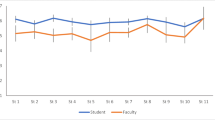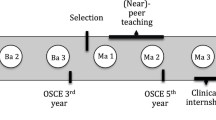Abstract
Background
Professionalism is a key competency in first year medical gross anatomy instruction, yet there is a paucity of longitudinal studies addressing professionalism attributes into year 2. This study longitudinally compared 160 preclinical medical students’ peer professionalism evaluations in two small group settings (year 1 anatomy lab and year 2 team-based learning (TBL) sessions) for 2013–2014 and 2014–2015.
Methods
Students were evaluated by their small group peers on a scale (0–3) on five professionalism domains (teamwork, honor/integrity, caring/compassion/communication, respect, responsibility/accountability) at mid-term and end of semester in years 1 and 2. Statistical comparisons were made between the formative (mid-gross) and summative (post-gross) anatomy ratings and between the summative anatomy (post-gross) and mid-term TBL (mid-iTBL) ratings.
Results
Anatomy professionalism evaluations showed a significant increase from an average ranking of 2.49 at mid-term to 2.6 at the end of the semester, with increases in teamwork, honor/integrity, caring/compassion/communication, and respect. Summative anatomy evaluations (post-gross) were compared to mid-term second year TBL (mid-iTBL), showing significant increases in peer professionalism rankings with improvements in teamwork, honor/integrity, responsibility/accountability, and respect.
Conclusions
Significant improvements in peer evaluated professionalism were observed in multiple domains over time in the anatomy lab, with the exception of responsibility and accountability. These gains were maintained into year 2 TBL evaluations, with the exception of caring, compassion, and communication, suggesting that graded peer evaluation may improve professionalism behavior in small group settings.






Similar content being viewed by others
References
Shrank W, Reed V, Jernstedt C. Fostering professionalism in medical education: a call for improved assessment and meaningful incentives. J Gen Intern Med. 2004;19:887–92.
Members of the Medical School Objectives Project. Learning objectives for medical student education- guidelines for medical schools: report I of the medical school objectives project. Acad Med. 1999;74:13–8.
Accreditation Council for Graduate Medical Education. ACGME common program requirements. [downloaded 2016 May 3]. Available from: http://www.acgme.org/Portals/0/PFAssets/ProgramRequirements/CPRs_07012015.pdf.
Members of the Medical Professionalism Project. Medical professionalism in the new millennium: a physician charter. Ann Intern Med. 2002;136:243–6.
Lachman N, Pawlina W. Integrating professionalism in early medical education: the theory and application of reflective practice in the anatomy curriculum. Clin Anat. 2006;19:456–60.
Swick H, Szenas P, Danoff D, Whitcomb M. Teaching professionalism in undergraduate medical education. JAMA. 1999;282:830–2.
Kao A, Lim M, Spevick J, Teaching BB. Evaluating students’ professionalism in US medical schools. JAMA. 2003;290:1151–2.
Bandini J, Mitchell C, Epstein-Peterson Z, Amobi A, Cahill J, Peteet J, Balboni T, Balboni M. Student and faculty reflections of the hidden curriculum: how does the hidden curriculum shape students’ medical training and professionalization? Am J Hosp Palliat Care. 2017;34:57–63.
Yates J, James D. Risk factors at medical school for subsequent professional misconduct: multicenter retrospective case control study. BMJ. 2010;340:c2040.
Escobar-Poni B, Poni E. The role of gross anatomy in promoting professionalism: a neglected opportunity. Clin Anat. 2006;19:461–7.
Swartz W. Using gross anatomy to teach and assess professionalism in the first year of medical school. Clin Anat. 2006;19:437–41.
Pearson W, Hoagland T. Measuring change in professionalism attitudes during the gross anatomy course. Anat Sci Educ. 2010;3:12–6.
Camp C, Gregory J, Lachman N, Chen L, Juskewitch J, Pawlina W. Comparative efficacy of group and individual feedback in gross anatomy for promoting medical student professionalism. Anat Sci Educ. 2010;3:64–72.
Wittich C, Pawlina W, Drake R, Szostek J, Reed D, Lachman N, et al. Validation of a method for measuring medical students’ critical reflections on professionalism in gross anatomy. Anat Sci Educ. 2013;6:232–8.
Spandorfer J, Puklus T, Rose V, Vahedi M, Collins L, Giordano C, et al. Peer assessment among first year medical students in anatomy. Anat Sci Educ. 2014;7:144–52.
Alakija P, Lockyer J. Peer and self-assessment of professionalism in undergraduate medical students at the University of Calgary. Can Med Ed J. 2011;2:65–72.
Papinczak T, Young L, Groves M, Haynes M. An analysis of peer, self and tutor assessment in problem based learning tutorials. Med Teach. 2007;29:122–32.
Speyer R, Pilz W, Van Der Kruis J, Brunings J. Reliability and validity of student peer assessment in medical education: a systematic review. Med Teach. 2011;33:572–85.
Jones T. Creating a longitudinal environment of awareness: teaching professionalism outside the anatomy laboratory. Acad Med. 2013;88:304–8.
Krych A, March C, Bryan R, Peake B, Pawlina W, Carmichael S. Reciprocal peer teaching: students teaching students in the gross anatomy laboratory. Clin Anat. 2005;18:296–301.
Michaelsen L, Parmelee D, McMahon L, Revine R. Team-based learning for health professions education: a guide to using small groups for improving learning. Sterling, VA: Stylus Publishing; 2008.
Michaelsen L, Richards B. Drawing conclusions from the team-learning literature in health-sciences education: a commentary. Teach Learn Med. 2005;17:85–8.
Finn G, Sawdon M, Clipsham L, McLachlan J. Peer estimation of lack of professionalism correlates with low conscientiousness index scores. Med Educ. 2009;43:960–7.
Hojat M, Michalec B, Veloski JJ, Tykocinski ML. Can empathy, other personality attributes and level of positive social influence in medical school identify potential leaders in medicine. Acad Med. 2015;90:505–10.
McCormack WT, Lazarus C, Stern D, Small PA. Peer nomination: a tool for identifying medical student exemplars in clinical competence and caring, evaluated at three medical schools. Acad Med. 2007;82:1033–9.
Pohl CA, Hojat M, Arnold L. Peer nominations as related to academic attainment, empathy, personality and specialty interest. Acad Med. 2011;86:747–51.
Emke AR, Cheng S, Chen L, Tian D, Dufault C. A novel approach to assessing professionalism in preclinical medical students using multisource feedback through paired self- and peer evaluations. Teach Learn Med. 2017;29:402–10.
Kavas M, Demiroren M, Kosan A, Karahan S, Yalim N. Turkish students’ perceptions of professionalism at the beginning and end of medical education: a cross-sectional qualitative study. Med Educ Online. 2015;20:26614.
Youdas J, Krause D, Hellyer N, Rindflesch A, Hollman J. Use of individual feedback during human gross anatomy course for enhancing professional behaviors in doctor of physical therapy students. Anat Sci Educ. 2013;6:324–31.
Pawlina W, Hromanik MJ, Milanese TR, Dierkhising R, Viggiano T, Carmichael S. Leadership and professionalism curriculum in the gross anatomy course. Ann Acad Med Singap. 2006;35:609–14.
Bryan R, Krych A, Carmichael S, Viggiano T, Pawlina W. Assessing professionalism in early medical education: experience with peer evaluation self evaluation in the gross anatomy course. Ann Acad Med Singap. 2005;34:486–91.
Acknowledgments
The authors gratefully acknowledge the School of Medicine Class of 2017 for their participation in the peer professionalism evaluation study.
Author information
Authors and Affiliations
Corresponding author
Ethics declarations
Conflict of Interest
The authors declare that they have no conflict of interest.
Prior Presentation
A preliminary version of this study was presented as a platform presentation at the 2015 annual meeting of the American Association of Clinical Anatomists.
Appendix
Appendix




Rights and permissions
About this article
Cite this article
Brueckner-Collins, J., Klein, P., Ziegler, C. et al. Tracking Peer Professionalism Measures in Preclinical Medical Students. Med.Sci.Educ. 28, 503–513 (2018). https://doi.org/10.1007/s40670-018-0578-6
Published:
Issue Date:
DOI: https://doi.org/10.1007/s40670-018-0578-6




